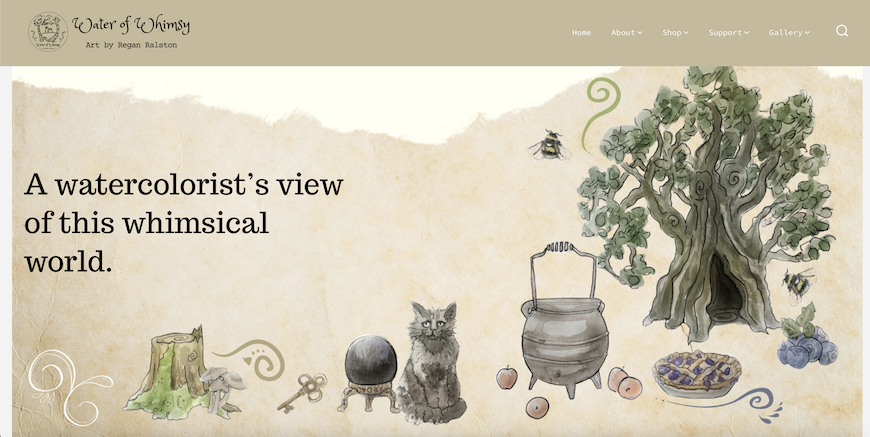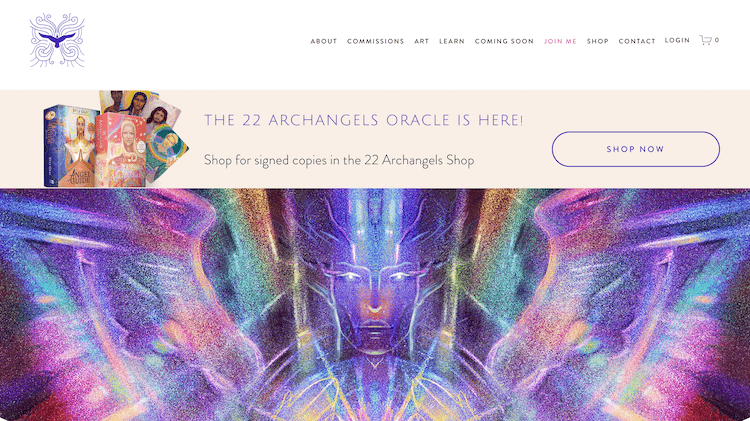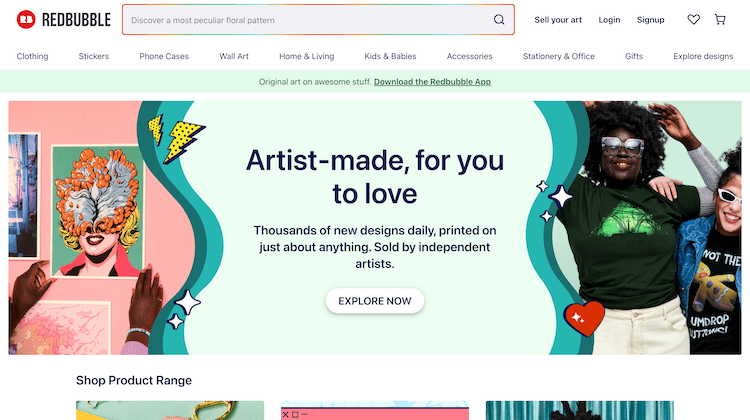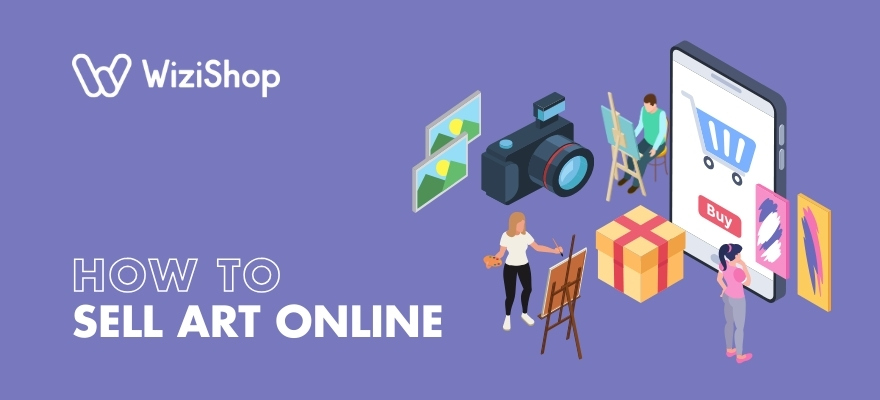Art has the power to revolutionize a living space, evoke a wide range of emotions, and spark thought-provoking discussions. From clay sculptures to oil paintings, graphic designs to photography, canvas to digital prints, there’s a type of art out there for everyone to appreciate!
What’s more, today’s artists have more opportunities than ever to showcase their work and even make a living from their passions and talent. Whether you’re an artist yourself or love curating special works for others, you might be considering starting your very own business selling art online.
Keep in mind that achieving success in online sales will require more than just an extensive enthusiasm for your favorite artistic medium. In this article, we’ll go over the steps for launching an online store involving the sale of art to ensure that you’re starting off on the right foot.
How to sell art online in 13 steps
As with anything in ecommerce since online shopping was created, the road to success for selling art on the internet will look different for every e-merchant. However, the following steps will help guide you as you begin your new entrepreneurial journey, allowing you to transform your passion into a profitable venture!
Table of contents
- 1. Decide if you'll be selling your original artwork or works by other artists
- 2. Choose what type of art to sell
- 3. Pick a business name
- 4. Learn about plagiarism and copyrights for artists
- 5. Create or source your art products to sell online
- 6. Determine how you'll print your art to sell
- 7. Photograph your products
- 8. Set your pricing
- 9. Build your art brand
- 10. Create an ecommerce website
- 11. Market your art business
- 12. Explore additional channels for selling your art
- 13. Collaborate with galleries to sell your art
1. Decide if you'll be selling your original artwork or works by other artists

Photo by Jadson Thomas on Pexels
When launching your own online art business, the first thing you’ll need to do is decide if you’ll be selling your own creations or those created by other people. Each option comes with its own advantages and disadvantages, and the best choice will depend on your individual interests and business goals.
- Selling your own art
Making and selling your own art online is a great way to transform your passion into a profitable business. Being the artist yourself, you’ll have the most control over the products you sell and when they’re available to be sold.
While artists of days gone by often had to rely on an art gallery to get their creations out in front of potential buyers, they can now take advantage of the internet to promote and sell their works. With the introduction of new sales and marketing channels combined with the vast array of creator tools accessible today, selling directly to customers is easier than ever before for artists.
Of course, selling your own handmade items isn’t all sunshine and rainbows. Depending on the type of art you produce, there may be a lot of time and creativity involved in making each piece. If your creation isn’t purchased as quickly as you’d hoped it would once you put it online, you may find yourself wondering if you’ve just spent tons of resources on a product that won’t necessarily earn a profit. In addition, you should verify that there’s actually demand for the type of art you want to make and sell.
- Selling other people’s art
Maybe you feel like you don’t have an artistic bone in your body but have a great eye for discovering amazing works of art. Or perhaps you enjoy making art but want to keep doing so as a hobby rather than turn it into a means of earning a living. If either of these statements apply to you but you still want to sell art on the internet, you may want to consider curating and selling the creations of other artists.
There are plenty of artists out there who want to focus purely on creating their art rather than marketing and selling it. Why not launch an ecommerce business that involves you managing these tasks for them? The artists can then concentrate on harnessing their energy for their art while you get to earn a percentage of the profits whenever one of their pieces is bought from your online store.
The downside of selling other people’s art, however, is that the amount of control you have is reduced compared to selling your own creations. You’ll be dependent on others for your product catalog, and even with the best of intentions and planning, delays and unexpected challenges are bound to come up occasionally, as is especially the case in any business involving a creative field.
2. Choose what type of art to sell: Prints, paintings, drawings, sculptures, etc.

Photo by Anna Shvets on Pexels
Watercolor or oil-based paintings, charcoal pencil drawings, clay sculptures, photography, canvas or paper prints, digital creations… There’s a wide range of types of art to choose from when launching an ecommerce business selling artistic goods. Whatever your favorite medium, you’ll be able to create or curate items to offer on your online store to sell to customers.
However, even if you’re a fan of multiple forms of art, it’s important to select a specific niche for your business. Trying to appeal to every single art-loving consumer out there will only lead to frustration and probably a loss of time and money. Focusing on a particular type of art and determining an ideal buyer are much more likely to help you achieve success.
In addition to choosing the type of art you want to sell, you’ll also need to decide on the format. The format you select will have an impact on various aspects of your business, including product pricing, photos, packaging, shipping, and more.
- Original art
If your chosen niche involves physical goods, you have the option to sell original artwork on your online store. Whether you’re making the items yourself or curating them from another artist or multiple artists, selling original art is perfect if you want to target consumers who love the idea of purchasing bespoke pieces to decorate their spaces.
Original art can generally fetch much higher prices than copies, although it also usually requires a lot more investment in terms of time to produce each product.
- Digital files, copies, or prints
While digital files, copies, or prints are usually priced lower than original products, they allow you to generate unlimited sales from a single work of art. Furthermore, they provide more flexibility, as you can supply shoppers with different sizes, allowing them to choose the option that best suits their needs.
Keep in mind that you can always opt to sell your art in multiple formats. For example, say that you paint watercolor illustrations featuring dragons in modern-day environments. You could sell your original painting of a dragon meandering through Times Square for a certain amount but offer canvas or paper prints of the illustration at a reduced price as well to attract a wider range of customers.
- Custom art
Another route to take when selling art online is to create made-to-order works requested by your customers or custom pieces commissioned by businesses or other organizations. This strategy allows you to engage directly with customers, creating personalized pieces that often feature high price points due to their bespoke nature.
This model can enhance customer loyalty and reduce inventory costs, as you produce only what is ordered. However, you should be cautious about managing time and expectations, ensuring that you can meet deadlines and maintain quality. It's also important to set clear terms regarding revisions and cancellations to avoid disputes and financial losses.
- Merchandise
You can also print your art on a variety of types of merchandise, such as t-shirts, hoodies, greeting cards, phone cases, coffee mugs, tote bags, stationery, etc. Selling merchandise is an excellent way to monetize art online because it allows you to diversify your income and reach wider audiences by transforming artwork into functional items that people use daily.
If you opt to print your artwork on merchandise, note that it's best to choose high-quality products that reflect your art's aesthetic value, ensuring consistency in brand image. Quality control is crucial; poor-quality items can damage reputation. You should also consider the costs of production and shipping to maintain profitability.
- Licensing
Licensing allows artists like yourself to generate recurring revenue from their creations while retaining ownership. In art licensing, the artist grants a company the right to use their artwork on products or in media in exchange for royalties based on sales. This model enables you to reach broader markets without the overhead of manufacturing and distribution.
To successfully license your artwork, it's crucial to have a diverse portfolio that appeals to potential licensees, showcasing versatility and marketability. Networking with companies and attending trade shows can help in securing licensing deals. Always ensure your contracts clearly define the scope of usage, duration, and compensation.
Be cautious about exclusivity clauses and the extent of the rights you are licensing. It's always advisable to consult a legal expert to review agreements to protect your rights and ensure fair compensation for the use of your art.
3. Pick a business name

Photo by Patrick Perkins on Unsplash
Picking the right business name when selling art online is a crucial step, as it significantly influences first impressions, brand identity, and overall marketability. A well-chosen name can effectively communicate the essence of your art, attract the target audience, and help differentiate your business from competitors. It serves as the foundation of your brand identity, impacting how customers perceive the values and aesthetics of your art.
The easiest method for selecting a business name is to either use your own name or a descriptive term related to your activities. For instance, if your name is Mary Smith and you create prints featuring people's pets, you might opt to name your business "Mary Smith Pet Portraits."
However, if you want a more creative name for your art business, consider the following tips:
- Reflect your art: Choose a name that mirrors the style, emotion, or themes of your artwork. This coherence helps potential buyers immediately connect with what you offer.
- Be memorable and unique: Opt for a name that’s catchy, easy to pronounce, and remember. Stand out by avoiding overly generic names that might blend in with others in the industry.
- Take online presence into consideration: Ensure the name isn’t already in use by checking domain availability and social media handles. A unique name simplifies setting up a website and accounts, aiding in your digital marketing efforts.
- Keep it scalable: Avoid overly specific names that might limit your business as it evolves. For example, a name like "DesertScapes Paintings" might limit future ventures into other styles or mediums.
- Seek feedback: Before finalizing, get opinions from peers, potential customers, or mentors. They can offer insights into how the name might be perceived by others.
- Legal availability: Check for trademark conflicts to avoid legal issues. Registering your business name legally protects it and enhances professional credibility.
Choosing the right name is more than a formality; it's an integral part of your business strategy in the art world, directly influencing your ability to engage and expand your customer base.
4. Learn about plagiarism and copyrights for artists

Photo by Markus Winkler on Unsplash
Having a good understanding of plagiarism and copyright laws is crucial for you as an artist selling your work online, as it helps protect your creations and respects others' intellectual property.
Awareness of these legal frameworks ensures that you will be able to safeguard your rights to your work, preventing unauthorized use and reproduction. It also enables you to avoid legal issues by ensuring that any elements derived from existing works are properly licensed or fall within the parameters of fair use.
With the surge of web commerce and the introduction of artificial intelligence, plagiarism is at an all-time high. Fortunately, there are several precautions you can take to protect your work online.
To start, you should always copyright your original creations, which provides legal ownership and the ability to pursue infringement cases. Watermarking images and using low-resolution samples for online display can deter unauthorized copying and distribution.
In addition, registering with online copyright management services or platforms that monitor and enforce copyright can provide additional security. Finally, educating yourself about the specific copyright laws relevant to your country and the international market is essential for navigating the complexities of online art sales.
5. Create or source your art products to sell online

Photo by Eugen Aschenbrenner on Unsplash
If you don't already have a catalog of items on hand, it's time to get to work and start creating or sourcing the pieces you plan to sell!
Whether you're making prints, t-shirts featuring a special design, ceramic mugs, or other types of artistic goods, be sure to focus on quality and uniqueness to stand out from competitors. You'll also want to use high-quality materials to ensure durability and aesthetic appeal.
As an entrepreneurial artist, it'll be advantageous to research current trends via blogs and other platforms to align your creations with consumer interests while infusing your personal artistic style. You might also think about creating a series or theme for consistency in your offerings.
If instead you plan to source the products to sell on your store, you can start by prioritizing building relationships with emerging and established artists. Attend art shows, galleries, and fairs to discover unique pieces and connect with creators who you might like to work with.
Remember to take the current consumer demand into consideration to select pieces that resonate with potential buyers. Ensure authenticity and quality by working directly with artists or reputable dealers. One last note: don't forget to always secure the necessary rights and documentation for selling the artwork on the internet.
6. Determine how you'll print your art to sell

Photo by George Milton on Pexels
Next, you'll need to find a way to print your designs to sell to shoppers. Of course, if you don't plan to sell prints of any kind, feel free to skip ahead to the following step!
There are multiple options for how to go about printing your artwork, including managing it yourself from the comfort of home or locating a professional printer to take care of it for you, and the optimal path will largely depend on the items you wish to sell and your budget.
- Printing products yourself
If you've got a decent office printer as well as high-quality paper and ink at home, there's no reason why you can't start off by making great prints on your own to sell. This method can give you the most control over your finished products and save you money.
Note that while this strategy is generally used for prints involving paper, you can opt to invest in a specialty home printer that allows you to print on canvas or different types of fabric. Regardless of the types of prints you make, as your business grows, you'll probably need to start to work with a professional service to print your creations.
- Working with a professional printing company
If you have a limited selection of pieces that sell frequently, collaborating with a local or digital printing service may be a good idea. With this tactic, you'll likely have a greater variety of printing options and be able to achieve better quality prints due to these companies' sophisticated printing technology.
Be sure to shop around to find a printing company that offers a price to fit your specific budget. Although this method is generally going to be more expensive than if you were to print items on your own, many printing companies give discounts for bulk orders, especially if you wish to print numerous copies of items with the same design.
This printing option is more convenient than managing the printing on your own, but remember that you'll still need to package and ship the prints you sell.
- Using a print-on-demand service
The easiest way to sell art on the internet by far is by offering print-on-demand creations. Using this strategy, the print-on-demand service integrates with your shop, whether you sell your work on your own ecommerce site or via digital platforms like Etsy. When somebody purchases one of your pieces, the integrated system automatically initiates the printing and direct shipment of the item to the buyer.
With this hands-off approach, you simply need to upload your designs in a digital format and let the printing company do the work for you. As the price of print-on-demand services can vary, be sure to look for digital print-on-demand platforms that are going to suit your budget and your printing needs.
7. Photograph your products

Photo by cottonbro studio on Pexels
No matter what you sell online, it’s crucial to provide shoppers with high-quality product images that give an accurate representation of each item in your catalog. That being said, it’s even more advantageous when you’re selling works of art, as you’re trying to attract shoppers in an industry where aesthetics are of the utmost importance.
For physical goods, this means taking photos of your products yourself or hiring a professional photographer to do it for you. Note that photographing art can be a little more difficult than other products, as the wrong light setup can easily create a glare or make the piece’s colors look different than they are. For this reason, going the professional route is generally best, but if your budget is limited, you can still produce great product photos with a bit of patience.
Availing of good lighting and shooting your products from multiple angles are very good starting points. Don’t hesitate to use lifestyle photos for your art as well, showing your products in real-life scenes, as this can allow your website visitors to better visualize an item or imagine using it for themselves.
If you sell digital files only, you can simply upload your images and add them to each product page on your site. However, lifestyle photos can be advantageous for this type of offering too. Say that you’re a photographer selling files of the photos you shoot. You might show your image being used on a mock website or hung on the wall in your living room—anything to aid a potential customer in picturing using the product in their daily life.
8. Set your pricing

Photo by Andrzej Gdula on Pexels
Deciding how to price artwork to sell online can be a tricky affair, especially when it concerns original pieces that you’ve created yourself. While there’s no limit to how much you can make in ecommerce, remember that the value of art is subjective. It’s therefore quite possible that you could spend hours, days, or even months working on a particular item and invest a certain amount of money in materials and not have anybody willing to buy it at the price you set!
Nevertheless, when determining how much to charge for your artwork, you can begin by simply adding up your costs to sell and market the product, your material costs, any other expenses, and the profit you hope to earn. The total sum will be the piece’s retail price.
At the start, it can be very easy to undervalue your work and price your goods in a way that doesn’t really fairly compensate you for your time. While you’ll of course want to not set prices that are so high that they scare potential customers away, don’t price your products so low that they aren’t profitable.
Researching how artists with a level of experience similar to yours price their creations can give you a good idea of where you should aim for your own store. If you find that your online store isn’t selling, you may want to lower your prices, at least until you build up more of a following.
If you’re not selling original works of art, your prices are likely going to be comparably much lower, but you’ll still want to take all your expenses into account for selling digital files, copies, or prints. In addition to the costs mentioned earlier for original goods, you might need to think about fees for printing, software, professional services, etc., for instance.
9. Build your art brand

Source: Water of Whimsy
Whether you’re selling your own works or those of other artists, building your brand is an important step. People buy art for a wide variety of reasons, with there often being an emotional component involved. Building and clearly defining your brand will help you to better connect with your target audience and stand out from the competition.
So how do you as an artist actually build your art brand? While your exact strategy is going to depend on your business setup and type of art you sell, here are a few tips that can help start off on the right foot.
- Define your brand values and mission: What’s important to you? This should concern not just the art you create or curate for your store but also your business operations. Once you’ve defined these elements, you’ll want to be sure to convey them clearly and consistently on your website and in any of your communications.
- Choose how you’ll tell your brand’s story: Do you want to get personal with your audience or remain a bit more mysterious? With the plethora of online store’s selling art these days, brand storytelling is more important than ever. It’s a powerful tool for drawing in shoppers, making them want to learn more about your brand, and transforming them into loyal customers.
- Work on your brand identity: Your brand’s name, color scheme, logo, slogan, tone and vocabulary, typography, etc. all serve to craft your brand identity and help consumers to more easily recognize and remember your business. These elements might be found on everything from your ecommerce site and socials to your business cards, product packaging, and more.
10. Create an ecommerce website for optimized online selling

Source: Jennifer Hawkyard
For you to have the most control over your business and your brand’s web presence, you’ll want to be sure to have your own ecommerce site. Of course, having a stellar online store builder at your side to assist you with launching and managing your website can make all the difference in ensuring a seamless, enjoyable experience with your new entrepreneurial adventure.
With the WiziShop all-in-one ecommerce solution, you’ll be able to build a customized online store that accurately reflects your art brand by choosing from one of our many design templates available. With over 400 onsite features designed to increase your conversion rate, a team of friendly and knowledgeable Business Coaches to answer any questions you have concerning your online store, and free training on all kinds of ecommerce-related subjects, our platform is perfect for new and experienced online sellers alike!
In addition, our 50+ technical SEO optimizations can help boost your website’s rankings on Google, driving more traffic to your online store and increasing views of all the amazing works of art you offer.
Are you planning on running a solo operation and worried that you may not be able to devote a sufficient amount of time to creating content for your ecommerce website? Besides the aforementioned features and benefits you’ll get to take advantage of when choosing the WiziShop ecommerce platform, you can also avail of our powerful artificial intelligence. From the moment you sign up, you’ll have access to our AI feature that allows you to produce content like product descriptions, text translations, blog articles, meta descriptions, etc. much more efficiently!
Sign up with WiziShop today and enjoy a 7-day free trial. After that, choose from one of our various subscription plans, which begin at $24.90/month.
Try WiziShop free for 7 days
THE EASIEST NO-CODE ECOMMERCE SOLUTION✅ No credit card required
✅ Access to all features
✅ No commitment
Keep in mind that when it comes to selling art online, several pages on your website are going to be particularly crucial to ensure a smooth user experience and effective showcasing of your work:
- Homepage: This is often the first point of contact with potential buyers. It should be visually appealing and clearly communicate your brand's identity. Be sure to feature high-quality images of your artwork and easy navigation to other sections of your site.
- Gallery or portfolio page: This page should display your products in a well-organized manner, allowing visitors to easily browse through your collections. Each piece should be accompanied by high-quality images and details like title, size, medium, price, and a brief description.
- About page: This personalizes your site by sharing your biography, artistic philosophy, influences, and any professional accolades. It helps build trust and connect emotionally with your audience.
- Product pages: Essential for direct sales, these pages should offer a seamless shopping experience. Include clear pricing, compelling product descriptions, availability status, shipping information, and an easy-to-use checkout process.
- Contact page: Provide a way for visitors to contact you. Include an email address, contact form, and optionally, your business phone number and studio address. Social media links can also be added here to boost engagement.
- FAQs: Address common customer inquiries here, such as details about shipping processes, return policies, and how to care for purchased artworks.
- Blog: Regular updates on this page can engage visitors with behind-the-scenes content, upcoming exhibitions, new projects, or general news about your art career. This can also aid in SEO to attract more visitors.
These pages form the backbone of an effective art-selling website, providing a comprehensive and engaging online presence that can attract and retain buyers.
11. Market your art business
Source: @amandaclarkartist on Instagram
After launching your online store, you’ll need to start marketing your business so that the people you’re trying to reach, namely those consumers interested in the kinds of art you offer on your website, know that it exists.
In order to reach the greatest number of people possible, it’s a good idea to implement a variety of tactics into your marketing strategy. Fortunately, there are many different ways, free and paid, to promote your art and boost traffic to your website and/or other sales channels. You’ll just need to determine which marketing channels work best for your store and ideal buyer.
- Build your following on social networks by consistently sharing high-quality content on the most pertinent networks for your buyer persona. Some artists even start working on their presence on these platforms before launching their online store to generate interest. This is one of the best methods for connecting with current and potential buyers alike, as the number of global social media users is higher than ever. Plus, posting organic content on most networks is completely free. It’s therefore a must for any ecommerce entrepreneur but especially those with limited budgets.
- Work on your website’s SEO to improve your visibility on search engines. Another no-cost way to market your business, ecommerce SEO involves numerous actions, such as performing keyword research to help optimize your product pages, category pages, blog, and other website content; publishing relevant, authoritative content on a regular basis, optimizing your images by using alt text and ensuring that they’re the right size; obtaining backlinks; formatting your URLs correctly; and more. As a reminder, WiziShop will take care of all the elements of technical SEO for you when you use our platform to build your online store!
- Develop a well-rounded content marketing strategy to boost your SEO and further drive organic traffic to your site. Content marketing is a powerful tool in online sales that entails crafting engaging and informative content that prioritizes helping your audience rather than promoting your products directly. It can assist with growing brand awareness and trust, generating leads, increasing conversions, and bringing other benefits. Blog articles, posts on social networks, infographics, ebooks, podcasts, and customer testimonials are just a few of the different types of content marketing you might consider using in your strategy.
- Launch paid advertising campaigns for faster results. If your marketing budget allows it, investing in well-targeted paid ads can help you to reach your audience more quickly. Furthermore, paid ads can often provide you with a lot of beneficial data that can help you to optimize your future campaigns, products, and services. You can take advantage of advertising on social networks like Facebook or Instagram or on Google with pay-per-click (PPC) ads. In addition, if you also have a presence on online marketplaces like Etsy, you often have the option to pay to promote your listings on these various platforms.
- Collaborate with influencers to expand your reach on social networks or elsewhere on the web. Influencer marketing is a particularly effective tactic for today’s ecommerce businesses. It involves working with somebody who has a large following to promote your products in exchange for free goods or money. The influencer has already built up a high level of trust with their followers on a specific social network or other platform, so there’s a better chance that these users are going to then want to check out your website and see what you have to offer. When researching potential influencers with whom you wish to collaborate, be sure to select somebody who’s well known in your specific niche and whose followers are likely to be interested in the type of art you have for sale.
- Consider expanding your strategy to include offline marketing to further boost exposure for your brand. While the majority of your marketing efforts will likely take place on the internet, offline tactics can be helpful too, especially when it comes to selling artwork. You might, for example, go to art shows, participate in outdoor art markets in your area, or conduct live workshops or demonstrations. Networking at local events and distributing physical promotional materials like flyers and business cards can also effectively attract local clientele and broaden their audience.
12. Explore additional channels for selling your art

Source: Redbubble
Along with having your own online store, you may want to consider expanding to other sales channels to widen your brand’s reach if your resources allow it. For instance, some art sellers also offer their products on general online marketplaces, such as Amazon or Etsy, or those designed more for artist creations, such as Fine Art America, Redbubble, Art Station, CafePress, Artfinder, and others.
You can also take advantage of social networks like Instagram, Facebook, etc. and sell your products directly to your followers/subscribers on your preferred platforms in addition to implementing them in your marketing strategy. Just be sure to research your niche beforehand to determine which social networks are most frequented by your target audience.
Utilizing online auction sites or participating in digital art fairs can tap into new collector networks. Each platform has its unique audience and selling points, so it's crucial to tailor your approach to fit the platform’s style and user expectations, ensuring your artwork resonates well with potential buyers.
13. Collaborate with galleries to sell your art

Photo by Markus Spiske on Pexels
Besides putting your artwork up for sale via your own channels, working with art galleries can be highly beneficial as an additional avenue. This kind of collaboration provides a professional platform to showcase their art to a targeted audience of art enthusiasts and collectors.
Art galleries not only offer physical space to exhibit artworks but also bring in their established clientele and marketing prowess, greatly amplifying an artist's visibility. And good news if you feel like your creativity has stagnated due to managing your art business: galleries often handle many of the logistical aspects of displaying and selling art, such as promotion, customer interaction, and sales transactions, allowing artists to focus more on the creative process.
The first step of starting a collaboration with an art gallery entails researching galleries that align with your style and artistic vision. This can be done by visiting gallery exhibitions, browsing their portfolios online, checking out their social media pages, and networking with other artists.
Once a suitable gallery is identified, it's time to prepare a professional portfolio of your work, including high-quality images, a biography, a resume, and an artist statement. An artist's statement is a written explanation provided by the artist about their work. This concise text supports and elucidates their creations, offering viewers deeper insight.
Note that approaching a gallery typically involves submitting this portfolio either through a formal application process or via direct contact with the gallery curator. While it may be tempting to shoot the gallery a quick DM on social networks, it's best to avoid this tactic and go a more professional route.
Finally, it's essential to understand the gallery's commission structure and contractual obligations before committing to ensure that the terms align with your expectations and career goals.
By partnering with art galleries, you'll be able to leverage assistance from experts to reach new heights in your artistic career and achieve greater market success!
Tips for packaging and shipping your art
Regardless of what an ecommerce business sells, its customers will expect their orders to arrive safely and undamaged. However, because your target market consists of consumers interested in art, it’s all the more important for you to also think about the visual appeal of the packages you send to your buyers. Creating a memorable unboxing experience can make the act of purchasing from your store even more enjoyable and help to increase customer loyalty!
To start, you’ll want to incorporate the various branding elements you worked on earlier, (color scheme, logo, etc.) into your packaging. For instance, you might wrap each item in the customer’s order with tissue paper in your brand’s colors secured with a sticker featuring your logo. Consider also slipping your business card, discount offers for future purchases, and little freebies such as a mini print or sticker with your artwork on it into shoppers’ packages.
Last but definitely not least, keep your artwork’s protection at the forefront when shipping orders. Depending on the type of art you sell, you could be mailing very fragile pieces that could easily get damaged during shipment if not packaged properly.
Do you plan on selling prints or poster-type goods? Begin by placing them in clear cellophane sleeves for added protection. Then, use rigid cardboard mailing envelopes for smaller items or cardboard tubes for works that require more space.
If you’re shipping expensive and/or very large works of art, there are extra precautions that you’ll need to take. Take canvas pieces, for example. You’ll likely have to buy your packing and shipping materials from a packaging supplier to obtain boxes with the exact dimensions you need as well as additional items to better protect the product, such as cardboard corners.
Finally, if you’re going to be shipping original artwork, you’ll definitely want to consider investing in shipping insurance. After all, if one of your prints gets lost or damaged in the mail, you can simply send the customer a replacement, but this isn’t a possibility for original creations. Research your delivery providers’ offerings for insurance coverage carefully to be sure that the option you select will adequately compensate you should you need to refund a customer due to a shipping issue.
Conclusion
Selling art online offers a plethora of opportunities for artists to reach a global audience and establish a thriving digital presence. Key strategies such as leveraging the right online platforms, engaging effectively with your audience, and optimizing your digital content are critical for success.
By utilizing high-quality images, crafting compelling stories, and offering excellent customer service, artists can enhance their online visibility and sales. Furthermore, staying adaptable and informed about new digital trends will ensure that your approach remains relevant and effective.
Whether you're a seasoned artist or just starting out, embracing these practices will help you navigate the vibrant and ever-evolving online art market with confidence and creativity!
Selling art online FAQ
Is it better to sell art online or in person?
Selling art online offers several advantages over in-person sales. Primarily, it provides a broader audience reach, allowing artists to connect with buyers globally, transcending geographic limitations. This increased visibility can lead to higher sales opportunities. What's more, online platforms often reduce overhead costs associated with physical galleries, such as rent and staffing, making it a more cost-effective option.
The digital format also allows for easier inventory management and the ability to showcase a larger portfolio without space constraints. Furthermore, internet sales enable continuous accessibility for shoppers, allowing purchases and interactions at any time, which is more convenient for both buyers and sellers.
That being said, selling art in person does offer the benefit of direct interaction, allowing artists to engage with customers, explain their work in depth, and build strong personal connections that can enhance buyer trust and loyalty. In addition, buyers can view artworks firsthand, appreciating the textures, colors, and scale more accurately, which can significantly influence purchasing decisions.
Fortunately, you're not limited to one method when it comes to selling your artwork! Many artists today opt to start by launching an ecommerce site to sell their products, be they physical or digital prints, photography, original paintings, etc. and then make in-person appearances to boost sales at markets, galleries, and special events a few times a year.
What is the best way to sell your art online?
The best way to sell your art online is to create your own online store using a top-notch ecommerce solution like WiziShop. Remember that with the WiziShop platform, you'll have all the resources you need to succeed as an artistic entrepreneur selling your beautiful creations on the web: a plethora of design templates to create a homepage that suits your vision, a wide range of features to bolster your marketing strategy and make running your website super simple, powerful AI to assist you in the creation of all kinds of text content, free training, access to our knowledgeable Business Coaches, and more!
Depending on the types of products you wish to sell, you might also decide to expand your reach beyond your ecommerce site by making your creations available for sale on creator and artist digital marketplaces and platforms such as Etsy, Redbubble, etc. or social networks like Instagram.
Can you make money selling art online?
You can definitely make money selling art online, but how successful you are will depend on how you approach your business. Making money selling art online involves leveraging various platforms such as personal websites, online galleries, and social networks to reach potential buyers. It's crucial that you add high-quality digital images, provide detailed descriptions, and maintain an engaging presence on the internet to attract new customers to your store.
Different factors that may affect your profitability include the pricing of your products, the competitiveness of the online art market, your reputation as an artist, and the effectiveness of your marketing strategies. Furthermore, costs associated with maintaining a website, transaction fees, and shipping can impact the overall profitability.
Successful online art sales often depend on consistently producing compelling content, interacting with followers, and adapting to evolving digital trends and buyer preferences.
What is the best type of art to sell?
The best type of art to sell often depends on market demand and available resources. Art prints, for instance, are particularly popular due to their affordability and ease of reproduction. Selling prints allows artists to cater to a wider audience while conserving resources, as multiple copies can be produced from a single original work.
Keep in mind that the design and quality of the print play crucial roles in attracting buyers. Focusing on trending designs that meet current consumer preferences can significantly boost sales, making prints a lucrative and efficient way to distribute an artist’s work.
Can you work with galleries to sell your art?
Even if your primary focus is selling your art via your online store, you can also work with galleries to boost your visibility and reputation with art lovers and potential customers. Working with galleries also gives you access to professional marketing and sales support.
To find the right gallery to work with, you'll need to research and identify galleries that suit your art style and career goals. Attending gallery shows, networking with other artists, and participating in art fairs are effective ways to connect with gallery owners and curators.
When submitting work for review, be sure to prepare a professional portfolio that includes high-resolution images of their artwork, an artist statement, a biography, and a resume. It’s also crucial to follow each gallery's specific submission guidelines to increase the chances of a successful partnership.










